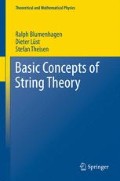Abstract
In this chapter we present various conformal field theory constructions which describe string theories in six and four space-time dimensions. We start with some general comments about strings moving in compactified spaces and then continue our investigation from Sect. 10.5 on strings in orbifold spaces. We then generalize the construction of non-oriented string theories to compact dimensions and discuss the prototype example of an orientifold on the compact space \({T}^{4}/{\mathbb{Z}}_{2}\). In this model we introduce fractional D-branes to cancel the tadpoles. Next, on a more abstract level, we outline the general structure a CFT must at least have in order to lead to a space-time supersymmetric compactification. Finally, we provide two concrete four dimensional realizations in terms of certain classes of \(N = 2\)superconformal field theories. The first are the so-called Gepner models and the second are heterotic generalizations of the covariant lattice approach from Chap. 13.
Access this chapter
Tax calculation will be finalised at checkout
Purchases are for personal use only
Notes
- 1.
- 2.
This defines an orientifold which is related by T-duality to the Bianchi-Pradisi-Sagnotti model (which is sometimes also called the Gimon-Polchinski model).
- 3.
The same condition can be found by requiring that condition (8.19) is invariant under \({p}_{i} \rightarrow -{p}_{i}\)and \(\vert \alpha \rangle = {P{}_{\alpha }}^{\beta }\vert \beta \rangle\).
- 4.
In the covariant formulation we would use \({I}_{1} = {\Gamma }^{9}\Gamma \)(with \(\Gamma = {\Gamma }^{0}\cdots {\Gamma }^{9}\)) on spin fields. In this case, \(\Omega {I}_{1}{(-1)}^{{F}_{L}}\)squares to one.
- 5.
Of course, for phenomenological reasons they also have to be broken, but we assume here that this is achieved at a different level, e.g. by fluxes or non-perturbative effects (see Chap. 17).
- 6.
We use the two-component notation for spinors and Dirac matrices in four dimensions. The Dirac matrices are \({\sigma }_{\alpha \dot{\alpha }}^{\mu } = (Vdash ,{\sigma }^{i})\)and \({\overline{\sigma }}^{\mu \dot{\alpha }\alpha } = (Vdash ,-{\sigma }^{i})\), where \({\sigma }^{i}\)are the three Pauli matrices. Two-component spinor indices are raised and lowered with \({\epsilon }^{\alpha \beta } = \left (\begin{array}{cc} 0 & 1\\ - 1 & 0 \end{array} \right )\), \({\epsilon }_{\alpha \beta }{\epsilon }^{\beta \gamma } = {\delta }_{\alpha }^{\gamma }\)and likewise for the dotted indices. We also define \({\sigma {}^{\mu u }{}_{\alpha }}^{\beta } ={ 1 \over 4} \left ({\sigma }_{\alpha \dot{\gamma }}^{\mu }{\overline{\sigma }}^{u \dot{\gamma }\beta } - {\sigma }_{\alpha \dot{\gamma }}^{u }{\overline{\sigma }}^{\mu \dot{\gamma }\beta }\right )\)and \({\overline{\sigma }{}^{\mu u }{}^{\dot{\alpha }}}_{\dot{\beta }} ={ 1 \over 4} \left ({\overline{\sigma }}^{\mu \dot{\alpha }\gamma }{\sigma }_{\gamma \dot{\beta }}^{u } -{\overline{\sigma }}^{u \dot{\alpha }\gamma }{\sigma }_{\gamma \dot{\beta }}^{\mu }\right )\). These are the Wess-Bagger conventions.
- 7.
In this section we use unnormalized vertex operators. We will discuss their normalization in Chap. 16.
- 8.
The same comment applies to the ten-dimensional effective action of the uncompactified theories. The fields which correspond to vertex operators in the (R,R) sector appear only through their field strengths.
- 9.
In these and the following expressions \(\alpha \)is not a spinor index.
- 10.
Similarly, \(SO(26)\)is simply enhanced to \(SO(26) \times U(1)\), where the \(U(1)\)appears to be anomalous and becomes massive via the Green-Schwarz mechanism (see Chap. 17).
Author information
Authors and Affiliations
Rights and permissions
Copyright information
© 2012 Springer-Verlag Berlin Heidelberg
About this chapter
Cite this chapter
Blumenhagen, R., Lüst, D., Theisen, S. (2012). CFTs for Type II and Heterotic String Vacua. In: Basic Concepts of String Theory. Theoretical and Mathematical Physics. Springer, Berlin, Heidelberg. https://doi.org/10.1007/978-3-642-29497-6_15
Download citation
DOI: https://doi.org/10.1007/978-3-642-29497-6_15
Published:
Publisher Name: Springer, Berlin, Heidelberg
Print ISBN: 978-3-642-29496-9
Online ISBN: 978-3-642-29497-6
eBook Packages: Physics and AstronomyPhysics and Astronomy (R0)

